In a new innovation of engineering, Intel has unveiled Hala Point, the AI world’s largest neuromorphic computer. This revolutionary system mimics the human brain’s structure and function for exceptional processing power.
What is Neuromorphic Computing?
Traditional computers excel at calculations and data extraction but need help with tasks that come naturally to humans, like pattern recognition and complex data analysis. Neuromorphic computing aims to close this gap by drawing inspiration from the human brain. These computers are designed with interconnected processing units that mimic the structure and function of neurons, the fundamental building blocks of the brain.
Hala Point Largest Neuromorphic Computer?
The Hala Point powerhouse system consists of a shocking 1152 Loihi 2 neuromorphic chips, making it the largest neuromorphic computer ever built. Each Loihi 2 chip has capabilities similar to a small brain region, and when combined in Hala Point, they create a formidable processing network.
The massive scale of Hala Point translates to impressive processing capabilities. The system is estimated to handle a mind-blowing 20 quadrillion operations per second (that’s 20,000,000,000,000,000 operations!). This processing power unlocks the potential for real-time analysis of complex data sets, making Hala Point ideal for various fields.
Other Possible Applications for HALA
Here’s a glimpse into the exciting possibilities Hala Point, the largest neuromorphic computer, presents:
- Space Exploration: Imagine robots traveling the rough terrain of asteroids, relying on real-time decision-making powered by Hala Point’s AI capabilities.
- Drug Discovery: The system’s ability to analyze vast datasets could revolutionize targeted drug discovery by accelerating the identification and development of new life-saving medications.
- AI Development: Hala Point can serve as a powerful platform for training and optimizing AI models, leading to the creation of more efficient and intelligent AI systems.
Challenges with the Development
While Hala Point marks a significant milestone, the challenges remain with its development. Developing software specifically designed for neuromorphic computers is an ongoing effort. Additionally, further research is needed to unlock the potential of these systems fully and integrate them smoothly into various applications.
Also! Brain-Computer Interface Research Shows Fast & Easy Results
Mike Davies, Director of the Intel Neuromorphic Computing Lab, expresses his enthusiasm for Hala Point’s performance: “Hala Point is a significant milestone in the development of neuromorphic computing. This system paves the way for a new era of AI that can tackle complex problems that are beyond the reach of traditional computers.”
Dr. Joanna Cohen, a leading AI researcher at Stanford University, highlights the transformative potential of neuromorphic computing: “Neuromorphic computers like Hala Point offer a fundamentally different approach to AI. As we delve deeper into this technology, we can expect breakthroughs in various fields, from scientific discovery to human-computer interaction.”
The unveiling of Hala Point signifies a new era in the field of AI. By mimicking the human brain’s structure and functionality, this new system unlocks doors for handling complex problems previously considered out of reach for traditional computers. While challenges remain in software development and system integration, the potential applications of Hala Point are vast and hold immense promise for revolutionizing various fields. As research progresses and software development catches up, we can anticipate even more remarkable advancements in neuromorphic computing.



